Menu
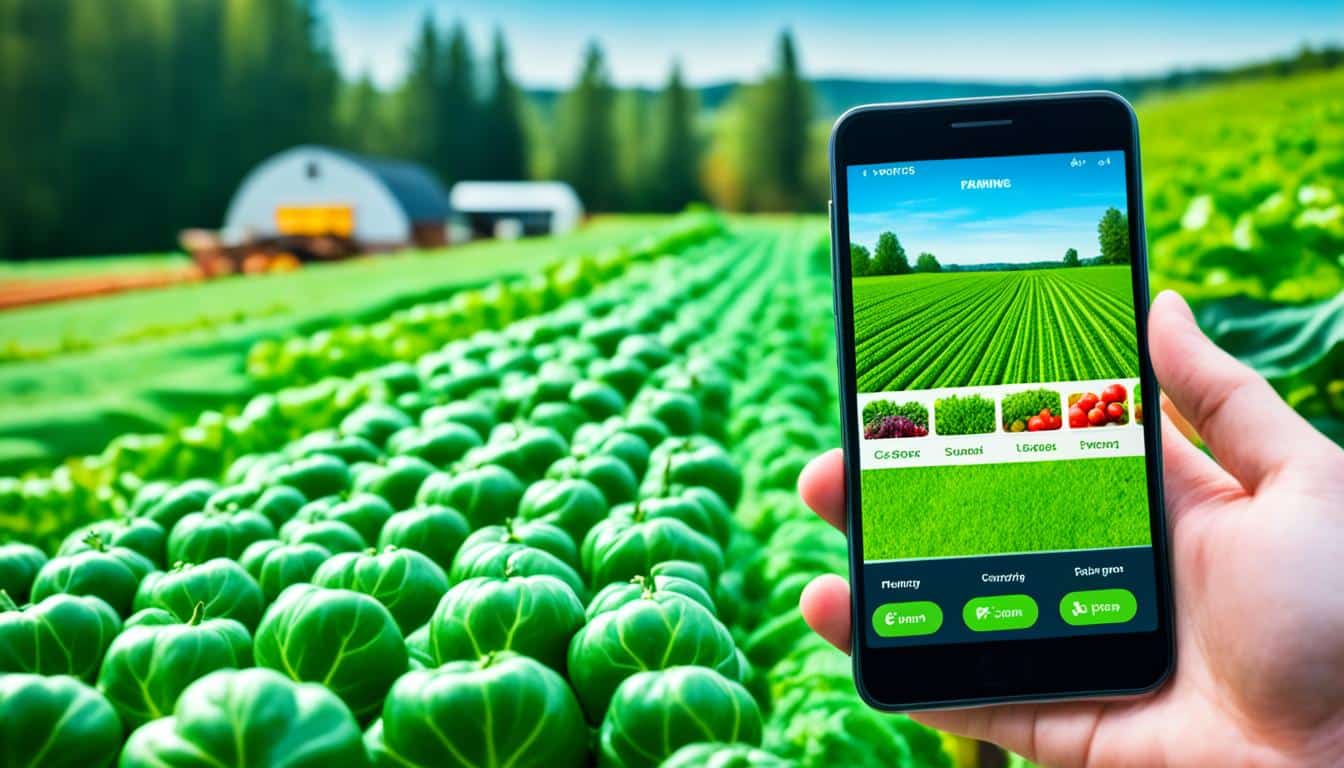
Did you know that there are over 30 mobile apps just for farming as of 2024? This shows how much tech has changed the way farmers sell directly to us. As tech improves, farmers use apps to talk to buyers, record info about their fields, and make buying from the farm more fun. Now, being online well is key for farmers who want to sell straight to us and do better at it.
In the farm tech world, a few apps are leading the way. yieldsApp is one. It uses AI to tell farmers how to manage pests, diseases, and nutrients better. This helps them grow in a way that looks after the land more. FarmCommand and Libra Cart also help farmers work better.
Mobile apps are changing how farms sell their goods directly. These farm produce apps offer a new way for farmers to handle their products, keep track of sales, and talk to customers. This change cuts out the need for middlemen, starting a fresh chapter in farming that’s both eco-friendly and clear.
These apps stand out by working on many devices. Most top agricultural management apps can be used on Android and Apple phones. Plus, many are free, making them open to lots of farmers. Big names like AGCO, John Deere, and New Holland are also jumping in. They’re showing they care about better farming by making tools for farmers to use.
The digital tools cover everything from equipment info to how to keep machines running smoothly. Around half of them offer detailed steps on how to get the most out of farm equipment. This shows there’s a wide range of apps to meet various farm needs.
| Feature | Description | Prevalence |
|---|---|---|
| Cross-Platform Accessibility | Available on Android and iOS | 70% |
| Free Availability | Offered at no cost | 60% |
| Brand Offering | AGCO, John Deere, New Holland | High |
| Task Focus | Planting, Harvesting, Spraying, Tillage | Varied |
| Equipment Optimisation | Includes detailed instructions and maintenance | 50% |
There are many Point of Sale (POS) systems out there for farmers. They do different things and cost different amounts. Farmers might pay for equipment, software access, credit card fees, and more.Some of these systems don’t take Electronic Benefits Transfer (EBT). But, others let farmers include EBT as a payment option. This step can help farmers sell more to a wider audience.
Using mobile retail platforms helps farmers sell directly with less hassle. This change makes farming more sustainable and clear to buyers.
Mobile apps are changing the game in farming, making it more efficient and eco-friendly. They help manage data in real time, make supply chains smoother, and make farming operations more transparent.
These apps are great for tracking resources and cutting waste, key parts of sustainable farming. They keep an eye on crops, spot issues early, and offer the latest on crop prices. Thus, farmers can make smart choices based on solid information.
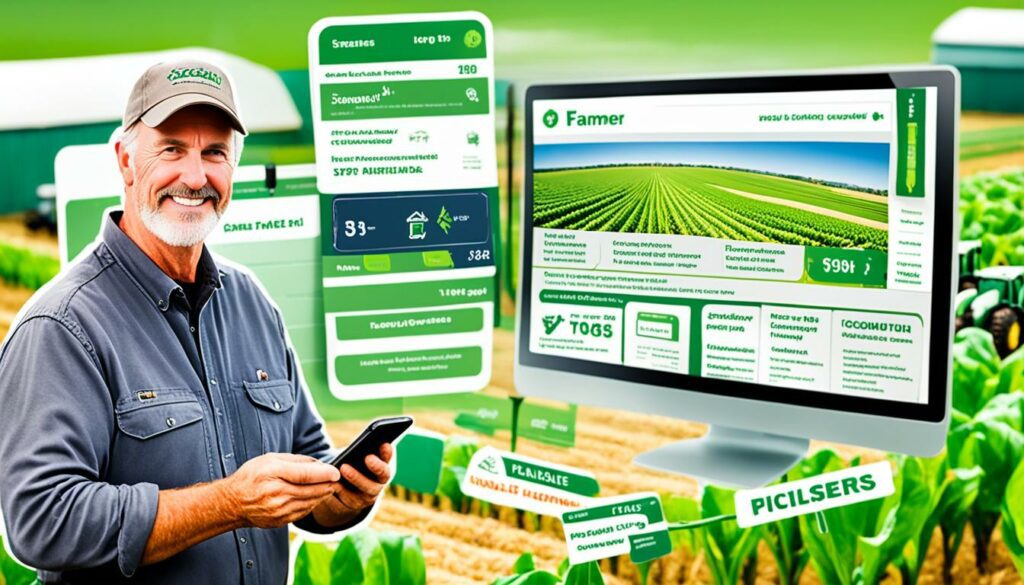
Mobile apps are also stars at giving advice on dealing with pests, diseases, and nutrients. They boost efficiency, which is super important as farms face fewer workers and the weather gets less predictable. They do this using IoT and Big Data Analytics.
| Feature | Benefit |
|---|---|
| Real-time Data Management | Improves decision-making and operational efficiency |
| Market Information | Enables informed decisions on crop sales |
| Resource Management | Minimises waste and promotes sustainability |
| Precision Agriculture | Overcomes traditional agricultural challenges |
| Financial Management | Keeps track of income and expenses for better budgeting |
Using apps for farm accounting also helps by keeping solid financial records. They provide vital insights for running the farm better. With agriculture apps becoming more popular, the future looks bright. The smart farming sector is expected to grow from $12.4 billion in 2020 to $34.1 billion by 2026.
In conclusion, mobile apps are vital for modern agriculture, making it high-tech and green. They use new technology and data to boost productivity and look after the environment.
In today’s world, the use of apps like FarmCommand and Libra Cart is crucial for managing farm data. They boost farm productivity and make selling easier for farmers.
FarmCommand leads the way in managing farm data. It gives weather forecasts specific to fields and blends these with machine info. This combo lets farmers make smart choices easily. The app collects data comprehensively and uses analytics well, upping farm productivity. With tools for today’s farming, FarmCommand changes how farmers run their operations. It merges old farming ways with new tech.
Libra Cart focuses on grain cart weighing and data handling. It lets farmers keep track of grain loads easily. This means getting precise data and analysis. Libra Cart’s smart data handling boosts farm productivity by offering exact measurements and live insights. It’s great for field work and managing resources smarter, showing tech made just for farmers.
FarmCommand and Libra Cart are prime examples of how modern tech boosts traditional farming. They make farms more productive and efficient. Spending on AI tech in farms is going up, and by 2028, it’s set to hit $4.7 billion. These apps will be key in managing farms in the future.
| App | Main Feature | Impact on Productivity |
|---|---|---|
| FarmCommand | Field-centric weather forecasts and machine data integration | High – Provides comprehensive data collection and analytics, aiding in informed decision-making and overall efficiency. |
| Libra Cart | Grain cart weighing and data management | High – Ensures accurate measurements and real-time insights, leading to optimized field operations. |
In smart agriculture, AI integration in agriculture is changing how farmers use mobile apps. It is expected to grow from $12.4 billion in 2020 to $34.1 billion by 2026. AI helps farmers improve their yields and manage their farms better.
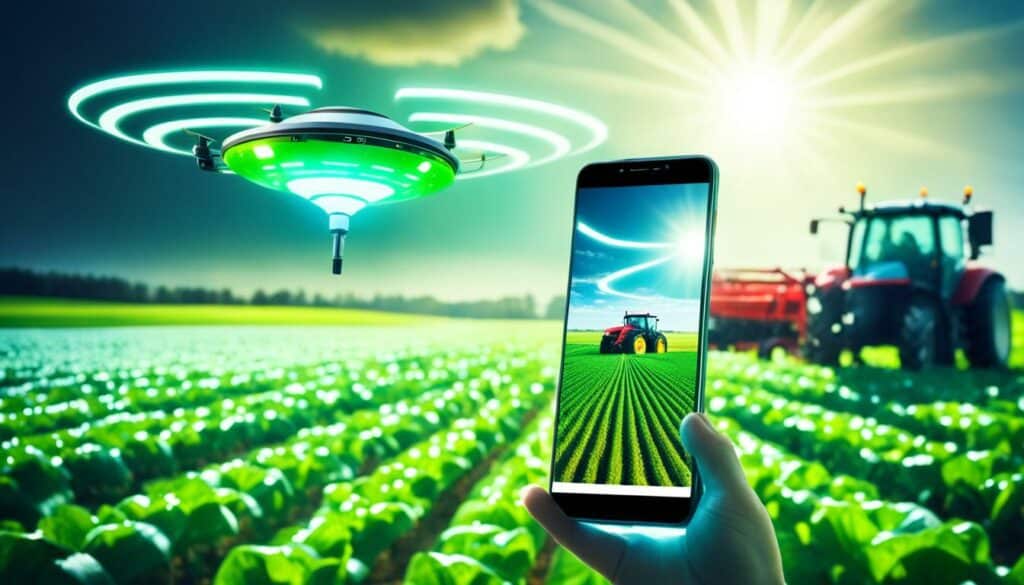
Apps like yieldsApp and AGMRI lead the way in using machine learning in farming. They give farmers precise insights and tips based on data. This makes farming more efficient and sustainable.
yieldsApp uses AI to manage pests, diseases, and nutrients. It looks at past data and current information to suggest actions. This helps farmers protect their crops and increase their harvest, saving resources along the way.
AGMRI is a platform that uses AI to study crops closely. It uses high-quality images and lots of data to show field details. This helps farmers spot and solve problems, like pests and not enough nutrients. It makes farming more effective and earth-friendly.
AI helps make farming better in many ways. It connects smart sensors with analytics to improve how crops grow. This can lead to less need for harmful chemicals, supporting sustainable farming and more profit.
Advanced farms in some countries use sensors that send real-time data to mobile apps. But even in places where farming is more traditional, apps make a big difference. They offer tools for better farm management to farmers everywhere.
AI apps are not just for crops. They help with water use too, making sure crops get just enough water. This is very important in areas where water is scarce. AI plays a key role in using resources wisely in farming.
As smart agriculture advances, AI in mobile apps is making farming better. It’s leading to farming that is more efficient, sustainable, and profitable.
Local Line serves more than 8,000 farms, showing how modern platforms connect farmers with customers. It works in many countries, allowing access to over 200,000 products. These services are part of the digital agriculture movement, helping farmers handle their sales better.
Local Line goes beyond just managing what’s in stock. It lets users manage things like how products are packaged, priced, and how customers pay. This is done with extra price lists at $30 a month. The platform also does special projects like Chipotle’s ‘Local Farmer Grant Program’, showing its innovative side in digital agriculture.
GrownBy is another key player, taking a 2 percent commission. It already has 60 farms and 1,200 consumers since June. Apps like Beet & Pear and WhatsGood are making a big difference too. They connect farmers, markets, and buyers. This builds strong local communities with more direct connections.
These advancements are changing mobile farmer’s markets. They give farmers new ways to show their products and talk to buyers. By using such technology, visits to farmer’s markets are becoming friendlier, clearer, and more efficient for everyone involved.
Farm-to-table apps are changing the way we deal with local produce. They make it easier for both sellers and buyers. The Create Your Farmers Market app stands out for making markets run smoothly. It’s another great example of how technology is helping us.
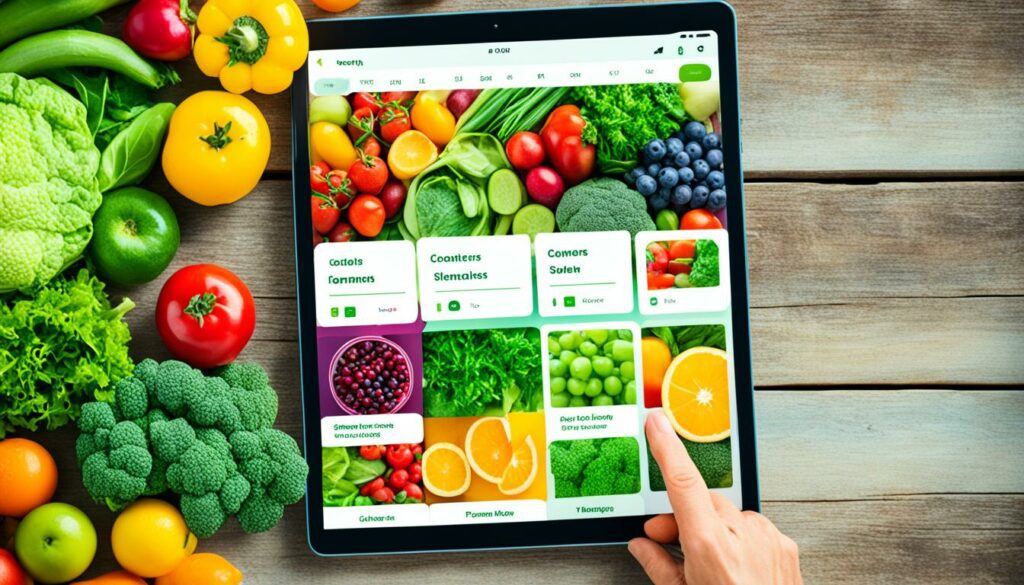
The Create Your Farmers Market app is all about helping farmers and sellers set up their stalls. It includes an easy-to-use map maker for stall layout. This means vendors can quickly find their spot. It also lets them take payments, making transactions fast and simple.
This app is key for anyone looking to do better at their local market.
Then there’s the POS mobile integration. This lets sellers at markets process payments right there. It’s quick and accurate. With this system, all sales are tracked perfectly. Farmers don’t have to worry about their money. They also get updated reports and can see how they’re doing.
All this helps make farm-to-table shopping a breeze. The more people use these apps, the more everyone benefits. It helps farmers, sellers, and buyers do well.
| Feature | Benefit |
|---|---|
| Advanced Map Builders | Efficient event layout planning |
| Integrated Payment Processing | Streamlined fee collection |
| POS Mobile Integration | Accurate and real-time sales tracking |
| Detailed Analytics | Informed decision-making |
So, these new tech tools are really changing farm-to-table business. Apps like the Create Your Farmers Market app are making things better for sellers and buyers. This tech helps us all do our jobs better and keeps customers happy.
Mobile apps are changing how farmers sell their produce. With direct selling apps, farmers can easily list what they’re selling. They also keep track of their stock in real-time and use advanced analytics to market better. These features are a must for farmers who love technology.
After checking out over 30 apps for agriculture, some really stood out:
| App Name | Function | Unique Features |
|---|---|---|
| FarmCommand | Field management | Field-centric weather data, crop health change detection |
| Libra Cart | Grain cart weighing | Integration with Case IH and New Holland |
| AGvisorPRO | Professional network | Real-time communication with experts in agriculture |
| Traction Mobile | Field task management | Field profitability, inventory tracking |
| Gripp | Operational tracking | Connectivity for teams and assets, cost-effective |
| ADM FarmView | Producer platform | Near real-time information on scale tickets, contracts, cash bids |
Marketing tools for farmers open up new ways to sell and improve sales plans. They let farmers look after soil, handle tasks, and talk to experts easily. For example, Slakes checks soil health, which is key for good farming results.
With digital marketplaces, farmers can run their farms better and reach more buyers. They help farmers watch their goods and talk well with their buyers. This makes selling what they grow smoother and more productive.
Apps like *Farmers Edge Partnership* and *Gripp platform* are changing how farmers work. They help farmers control and improve their sales and operations. Let’s explore these cutting-edge tools.
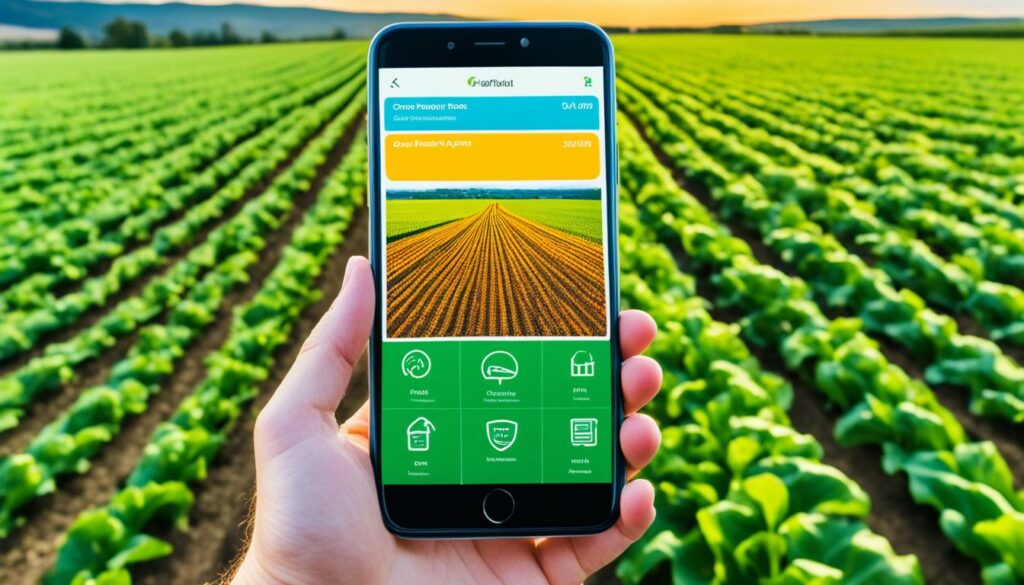
*Farmers Edge Partnership* uses advanced technology to give farmers real-time data. This allows farmers to take the best actions quickly. It includes predictive analytics and weather reports to boost farm efficiency.
The *Gripp platform* uses chat for easy teamwork on farms. It lets farmers talk and track their work easily. This system keeps everything in order, making farm life simpler.
Apps like these improve farm management a lot. They make farming more productive and easier to control. This leads to better sales and task handling.
Learn about other great farm apps below:
| App | Notable Feature | Users/Participants |
|---|---|---|
| GrownBy | Direct consumer registration | 1,200+ consumers |
| Beet & Pear | Social network for farmers | N/A |
| Harvie | Customised CSA boxes | N/A |
| WhatsGood | Connecting consumers and local vendors | N/A |
| Local Line | Extensive product categories | 200,000+ products available |
Digital tools are key to farming success. Platforms like *Farmers Edge Partnership* and *Gripp platform* boost farm efficiency and profits. They are crucial for modern farming.
Local food delivery apps are changing how we get fresh farm produce. They connect farmers and consumers, helping over 8,000 farms easily deliver over 200,000 products. This new way of buying food supports local farmers and builds a sense of community.
Local Line is leading the charge in local food distribution. It’s teamed up with Chipotle for a ‘Local Farmer Grant Program,’ showing how big companies can help sustainable efforts. This shows the key role these apps play in boosting local economy and cutting down on harm to the planet.
Melvin’s Farm to Fork is a great example. They’ve seen big improvements in their business thanks to Local Line. Gayle from the farm says it’s much easier to handle orders now. Using these apps, people can easily buy fresh food straight from local farms, helping those farms grow.
Local Line is now getting food from countries like the USA, Canada, and others straight to cities. This direct connection helps create a food system that’s sustainable. It builds trust and shows exactly where our food comes from.
Effective farm produce apps play a crucial role in modern agriculture. They offer user-friendly farm apps, inventory tracking, and real-time analytics. These are key for farmers wanting to improve how they work and boost productivity.

Libra Cart is a prime example. It links with Case IH and New Holland, expanding its user base. This shows how partnering improves inventory tracking and sharpens data management. With real-time analytics, it helps farmers act on information quickly, heightening their efficiency.
Apps like ADM FarmView, powered by Bushel, bring in real-time data for better asset management. Gripp, on the other hand, offers a chat-style tracker, aiding smooth team communication. This is key for large teams working in farming.
Apps that use AI are making big strides too. They offer precise advice and predictive data, transforming farming. For instance, AGvisorPRO boosts real-time connections among agricultural pros, enhancing problem-solving speed and accuracy.
| App | Key Feature | Benefit |
|---|---|---|
| Libra Cart | Integration with Case IH/New Holland | Enhanced market reach and interoperability |
| ADM FarmView | Real-time information | Improved operational efficiency |
| Gripp | Chat-styled tracking | Streamlined team communication |
| AGvisorPRO | Knowledge network | Real-time problem-solving |
In summary, user-friendly farm apps, excellent inventory tracking, and real-time analytics are vital in farming today. These features enhance how farms run and help farmers make better choices. This leads to sustainable and lucrative farming.
Choosing the right app for your farm can greatly improve how efficient you are. Look at what others say in reviews. Also, see if the app can be changed to fit exactly what you need for your farm.
Reviews from other users are key. Farmers Edge’s FarmCommand app mixes on-field data with weather updates and machine info. Libra Cart by Agrimatics is praised for its accurate grain cart weighing and managing the data, working well with different brands.
What other farmers say about using these apps matters a lot. They share what they liked and what they didn’t, which can’t always be found in the app’s info. Their experience can help you pick an app that works for your farm.
Being able to change the app to meet your farm’s unique needs is important. Traction Mobile focuses on tracking inventory and analysing field profits. Gripp helps with tracking daily tasks, making them more efficient and less costly.
Apps like AGvisorPRO and ADM FarmView let you talk to experts and get info in real-time. They offer features you can adjust to what works best for your farm. This means you get tools and advice that are just right for you, helping you manage your sales better.
Deciding after looking at reviews and your customisation options can make your farm more efficient. By combining real user experiences with tools that you can adjust to fit your farm, choosing the right app gets much easier. This can greatly impact your farm’s sales management.
The farming world is changing fast, thanks to new tech. Success stories show how mobile apps help farmers. These tools are great for using resources wisely and saving time.
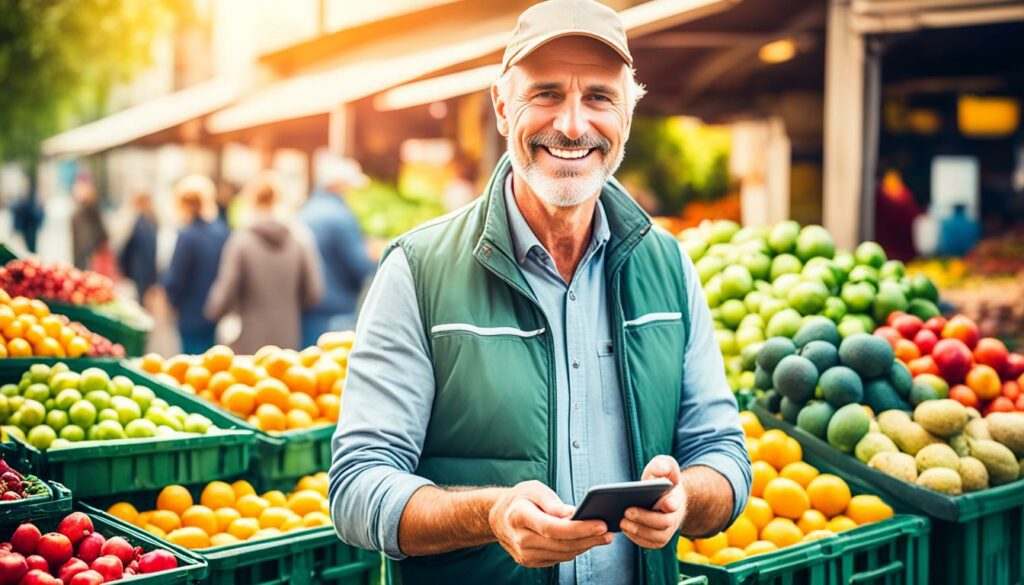
Farmers manage their land better with mobile apps. They help with growing crops, watering, and looking after animals. These apps bring market news and make keeping farm accounts easier. For example, Niger saw grain prices get more even, helping everyone.
The need for more food is making farmers try new things. Mobile apps not only increase work speed but also look after the land better. They warn about problems and help make smart choices. Plus, they cut costs and teach better soil care.
Stephen Kiguru from Kenya is a great example. He uses FarmDrive to keep track of his farm with just his phone. This simple upgrade has boosted his sales and made his customers happier.
Smart farming is growing quick, expected to reach $34.1 billion by 2026. This boom is because of tools like IoT and Big Data Analytics. They help farmers make more crops without harming the land.
There are loads of apps made just for farmers. They can deal with many farming needs like weather, crop quality, and land care. Farmers also use them to share info, borrow money, and buy things for the farm. The farming app market is doing very well, showing how important they are now.
Developing these apps is not easy. There are costs, tech issues, and not every farmer can read well. But, the good changes happening in farming are clear. More tech and smarter farming show a bright future for farms.
Future trends in farming apps will see big steps in AI and Blockchain. These steps aim to change how farming works. They will bring smarter ways to work, make better choices, and be more open in farming. This builds trust between farmers and those who buy their products.
The use of AI in farming is set to grow a lot. From $1.7 billion in 2023, it could reach $4.7 billion by 2028. Apps such as yieldsApp help farmers by giving smart advice on managing their fields against pests, diseases, and nutrition. Such apps make farming more productive by using real-time data.
AI in farming also means things like Traction Mobile for tracking inventory or FarmCommand by Farmers Edge for field data tools. These tools show how AI can make farming better.
Blockchain tech is quickly catching on in farming. It makes a clear and unchangeable record of transactions. This makes everyone from the farmer to the end buyer more trusting. Apps like ADM FarmView and AGvisorPRO are leading the way. They show that with Blockchain, you can trust where your food comes from.
Mobile apps have brought a big innovation in agriculture. They’ve completely changed how farmers do things. For instance, Farmers Edge’s FarmCommand helps with everything related to fields. Libra Cart by Agrimatics focuses mainly on grain cart weighing and data management. Both show how technology is reshaping farming.
There’s a lot that agricultural apps can do. Take Slakes, for soil health checks, and Traction Mobile, for tasks in the field. These apps meet different needs in farming. They make work more efficient. For instance, ADM FarmView and Agerpoint Capture help in analysing data and showing digital crop models.
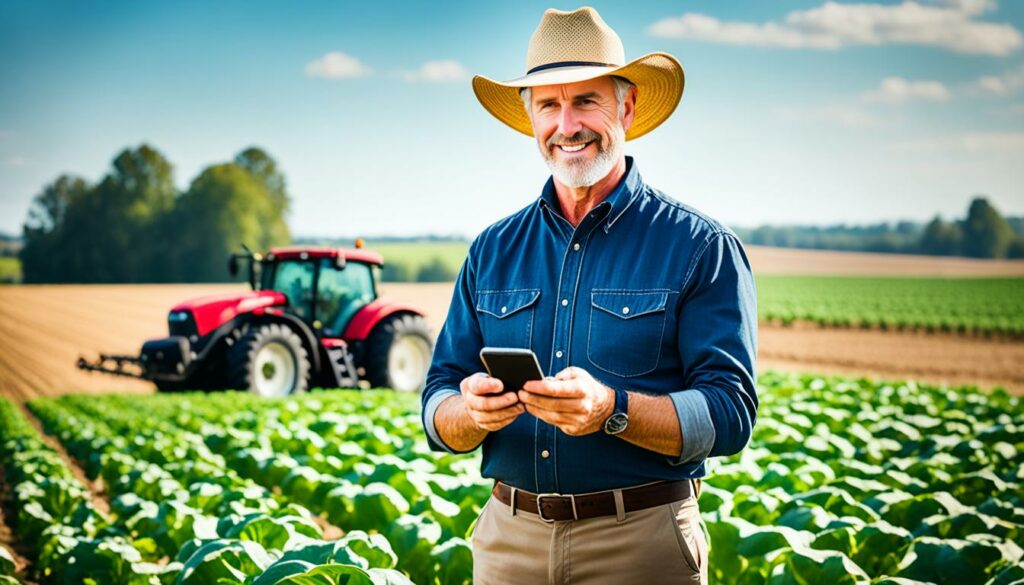
Looking closer at innovation, Agrology’s Fire Map gives up-to-date environmental info. DropControl manages irrigation, and GSI Connect improves grain drying. These apps highlight how tech is aiding sustainable farming.
Apps like JDLink and GoHarvest from John Deere show the move towards connected systems. They offer deep insights and boost farm efficiency. iBand-It and Tire Advisor help with keeping a close eye on equipment. They show the specific solutions available for farmers’ needs.
The rise of agricultural apps keeps making farming better. Platforms such as AGvisorPRO for sharing knowledge and Trimble Connected Farm for managing fleets are game-changers. They promise even more improvements in farming methods. This shows the strong technology impact on farming.
In conclusion, mobile apps are transforming the way farms sell directly to customers. They let farmers showcase their produce and run their farm better. From receiving timely weather alerts to managing crops using AI, these apps offer everything a farmer needs today.
The use of these apps is making a big difference. More than 70% of farmers are now using them to improve their methods. This has led to farming profits going up by as much as 30% in some areas. Also, 90% of farmers say using cloud storage makes managing their data a lot easier and more efficient.
This new way of farming has other benefits, too. It’s cutting down physical travel by as much as half for some farmers. This means they’re saving precious time and resources.
The future of farming tech looks even more promising. Thanks to advances in AI and blockchain, mobile apps will soon offer farming solutions that are more tailored, efficient, and transparent. This shift towards a farming model that’s more integrated and focused on the customer will help solve many of the challenges in agriculture. It will improve profits and make farming more sustainable.
This shows that mobile apps are more than tools. They are crucial parts of modern farming, driving the industry forward.
Mobile apps improve the way farms sell directly. They boost efficiency and connect farmers and buyers. These apps help with updating stock in real time, making supply chains smoother. Also, they provide info on the latest market trends and what customers like.
Farm-to-table apps help farmers sell to people directly. This helps local areas and the environment. They encourage buying from local farms and deliver fresher food. This way, people know where their food comes from.
There are many mobile platforms for farm sales. They include ones for farmers markets and digital farm places. These platforms help farmers sell online and talk directly to buyers.
Great apps for farming are FarmCommand and Libra Cart. FarmCommand links to weather and machine data. Libra Cart helps with grain measurements and data.
Apps like yieldsApp use AI to recommend dealing with pests and nutrients. They’re for better crops and to help farmers know what to do to grow more.
Create Your Farmers Market is a top app for managing farm-to-table sales. It has maps to set up events and easy payment and sales features. These tools make managing a market easier.
Apps make it easier to sell farm goods by creating marketplaces. Farmers can show what they’re selling and learn what buyers like. They also help with making sales smoother.
Local food delivery apps help connect farm food with buyers’ homes. They’re good for the earth and support farms. They make it easier to buy farm food.
Look for apps that are easy to use and track items and sales, and secure to pay through. These features are key to running the farm well and learning how to do better.
Think about what others say in reviews and how much you can change the app to fit your farm. Reviews tell you what an app is really like. Customisable apps are great for specific farming needs.
Many farmers have found success using mobile apps to sell and manage their farms. They’ve sold more, improved how they deal with customers, and run their farms better.
We’ll see more AI and blockchains in future farm apps. AI will help farmers make better choices. Blockchains will make buying from farms more trustworthy. These trends will make apps better for everyone.